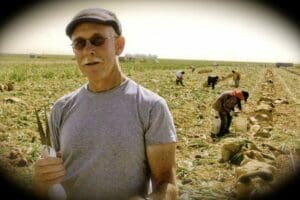Fresno: The Red and the Brown
October 1, 2020

David Bacon is a journalist and photographer covering labor, immigration and the impact of the global economy on workers.
In Fresno’s barrio, the taco trucks stay open past midnight. Young women from the neighborhood, out for fun and not ready to sleep, stand in line with a worker leaving her shift at the huge Amazon warehouse on Orange Avenue, hungry on her way home. Inside the truck masked cooks and servers bend and stretch to fill orders, working as hard as their customers who labor all day in fields and factories.

Masks in the taco truck are just one indication of Fresno County’s alarming COVID rate, with 27,717 cases and 382 deaths reported so far. For months the novel coronavirus has concentrated in the Latinx agricultural counties of the Central Valley. Urban Alameda County, for instance, with a much larger population, has a significantly lower rate — 21,189 cases and 406 deaths.

Fresno, crisscrossed by irrigation canals and railroad tracks, is the working class capital of California’s San Joaquin Valley, a city where people speak Spanish as readily as English. On Fresno’s main drag, Blackstone Avenue, the glowing neon names of restaurants don’t bother much with English, and signs like “Central Valley’s cerveza” need no translation.

If it weren’t for Mexicans, Fresno would never have become a city. In the wake of the violence that engulfed Mexico during its 1910-1920 revolution, tens of thousands fled north across the border. In Fresno they found work in the fields and homes in segregated barrios. Then countless families were pulled off the streets as the Depression deepened, loaded into boxcars and deported. Even U.S. citizens who looked Mexican were picked up and sent down to the border.

Racism and anti-immigrant hysteria were only part of the reason. Fresno in the early 1930s was a city of class upheaval. Thirty-two years before the 1965 grape strike in Delano, Mexicans rose up in an earlier vineyard rebellion – the 1933 Fresno grape strike opened a labor war that shook California. Today the street in front of the Azteca Theater is hauntingly empty at night during the pandemic, but in 1966, hundreds of local residents turned out to hear Cesar Chavez as the grape strikers marched up the valley.

Despite official hostility, generations of radicals have called Fresno home. Rufino Dominguez, a Oaxacan migrant with roots in Mexico’s left wing social movements, started the Organización del Pueblo Explotado y Oprimido (Organization of Exploited and Oppressed People) and led strikes when he arrived in Fresno in the 1980s. The Binational Front of Indigenous Organizations succeeded the OPEO, organizing indigenous Mexican migrants from an office in an old building on Tulare Street in the heart of Fresno’s scruffy downtown.

Mike Rhodes, who, with other Fresno activists, co-founded Community Alliance, one of California’s longest-lived community newspapers in California, spent 18 years writing articles denouncing the city for its abuse of homeless people, winning a $2.3 million class action suit in an effort to stop it.

According to the Department of Housing and Urban Development, in 2019 Fresno had a larger percentage of “unsheltered” homeless people — that is, people sleeping on sidewalks, in cars or in places the federal government calls “not suitable for human habitation” — than any other city in the country. Last April Rhodes interviewed Dez Martinez of the Homeless in Fresno advocacy group, who accused police of routinely destroying homeless encampments. “They do this daily,” she told him.

Rhodes accuses current Fresno Mayor and former Police Chief Jerry Dyer of seeking “the legal authority and enough officers to make homeless people’s lives a living hell.” Yet in spite of obstacles, political change may be coming. Mike Rhodes Day was declared by the city council in August 2018, and a new Latino majority was elected that November.

Anger over Fresno’s long history of discrimination, not unlike that which sparked the upsurges of 1933 and 1966, inspired Super_Tatt2’s mural remembering Vanessa Guillen, the soldier murdered at her Texas Army base in April. The city’s radical artists in the Barrio Art Collective charge that “Many people in the Valley do not want new jails or more cops, they do not want more oppression or more destitution, they do not want to see homeless people in the streets struggling every day … They want art, music and freedom.”

Today the city’s forlorn, iron gateway arch, which welcomed visitors when Highway 99 was a two-lane road, rises above an anonymous rail crossing, with warehouses on one side and the freeway frontage road on the other. Just down the street from this relic of old Fresno hundreds of people sleep on sidewalks and in vacant lots.

Further out, along the Mill Ditch canal, one homeless man, Adam, has built his shelter next to a fence along the levee. There Steve, another unhoused individual, pulls his cart loaded with blankets to the place he’ll sleep at night. Red and brown Fresno is still a bare-knuckle, hardscrabble city.

Copyright: Capital & Main 2020